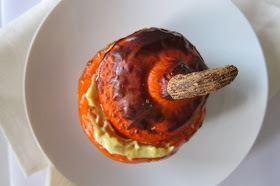 |
| Pumpkin Soup |
Squash and pumpkins come in all sizes, from 'Baby Bear' and 'Jack be Little', both around 10-18 cm in diameter, to the monstrous 'Atlantic Giant' which has been grown to over 300kg. They come in all shapes and colours too - the muted flesh coloured butternut; steel blue teardrop-shaped 'Blue Ballet'; dark green 'Table Queen' shaped like an acorn; fiery round 'Rouge vif d-Etampes'; dusky orange-brown 'Moschata Muscade' tasting faintly of nutmeg; the blue-black of the well-named 'Ironbark'; and the extravagantly top-knotted yellow/green/orange/white 'Turk's Turban'.
Although the French and Americans prize them, until fairly recently in the UK we mostly stuck to growing summer squashes. The simple reason for this is although pumpkins are easy to grow, a dry, warm period is needed to harden the skins for keeping through winter. A warm dry autumn here is not something we can take for granted but this year has been exceptional and harvests have been good.
 |
| 'Uchiki Kuri' Pumpkin Squash |
 |
| Pumpkin soup straight from the oven |
This adapted recipe comes from Simon Hopkinson's book The Vegetarian Option. Based on a classic Paul Bocuse recipe, Simon Hopkinson has paired back the original reducing the dish to its essence of pumpkin, cream and cheese. My adaptation is slight. Apart from reducing the quantities to work for a smaller pumpkin, I added some fried sage leaves at the end. They work but are they necessary? Frankly, no but if you want an extra something, sage makes a good partner for pumpkin. Like Hopkinson, I think the word 'soup' doesn't really describe this dish well. It's more of a creamed pumpkin. Whatever you want to call it, it is rich and absolutely delicious.
I used an 'Uchiki Kuri' weighing barely 500g here which was enough to serve two people but 'Jack be Little' would be a good choice if you wanted to serve individual ones. It also has the advantage of a softer, edible, skin.
Pumpkin Soup (Bocuse via Hopkinson)
(Recipe Serves 2 but can be easily scaled up)
1 pumpkin weighting 500g (1lb) or 2 smaller pumpkins
150ml (¼ pint) double cream
1 small garlic clove, flattened and peeled.
Salt and pepper
50g (2oz) Gruyere or Beaufort cheese, grated
A few sage leaves, fried until crisp (optional)
Preheat the oven to 200C (fan 180C)/Gas 6.
Heat the cream with the garlic, salt and pepper until it barely simmers. Take off the heat and leave to infuse for 20 minutes.
Slice off the top of the pumpkin a quarter of the way down to make a lid and keep to one side.
Scoop out the seeds and stringy membrane.
Strain the infused cream into the cavity and discard the garlic. Add the cheese. Top with the lid.
Bake in a roasting tin in the oven for about 1 hour until the flesh of the pumpkin is tender when pierced with a fork. The skin should be lightly browned - turn the heat down slightly if it is becoming burnt. Lift off the lid and add the crisped sage leaves for decoration (if using).
Serve with a crunchy salad.







